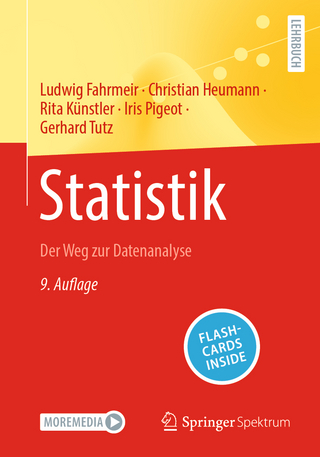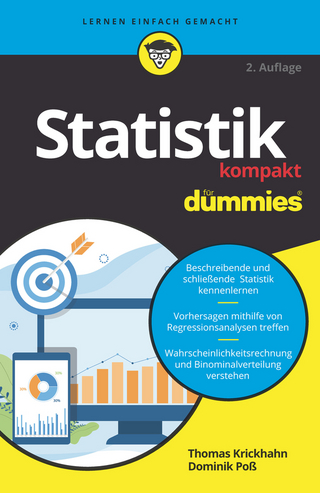
Seeing Through Statistics
Brooks/Cole (Verlag)
978-0-357-75750-5 (ISBN)
- Noch nicht erschienen (ca. Juni 2024)
- Versandkostenfrei innerhalb Deutschlands
- Auch auf Rechnung
- Verfügbarkeit in der Filiale vor Ort prüfen
- Artikel merken
Jessica Utts is professor emerita of statistics at the University of California at Irvine. She received her B.A. in math and psychology at SUNY Binghamton and her M.A. and Ph.D. in statistics at Penn State University. Aside from MIND ON STATISTICS, Dr. Utts has authored SEEING THROUGH STATISTICS and co-authored STATISTICAL IDEAS AND METHODS, both published by Cengage Learning. Dr. Utts has been active in the statistics education community at the high school and college levels. She served as chair of the Advanced Placement Statistics Development Committee and as Chief Reader for the A.P. Statistics Exam. In 2016 she was the president of the American Statistical Association, the largest professional organization in the world for statisticians. She is a recipient of the Academic Senate Distinguished Teaching Award and the Magnar Ronning Award for Teaching Excellence, both at the University of California at Davis. She is also a fellow of the American Statistical Association, the Institute of Mathematical Statistics, the American Association for the Advancement of Science and the Association for Psychological Science. Beyond statistics education, Dr. Utts�s major contributions have been in applying statistics to a variety of disciplines, most notably to parapsychology, the laboratory study of psychic phenomena. She has appeared on numerous television shows, including Larry King Live, ABC's Nightline, CNN Morning News and 20/20.
PART 1: FINDING DATA IN LIFE.
1. THE BENEFITS AND RISKS OF USING STATISTICS
1.1 Why Bother Reading This Book? 1.2 What Is Statistics All About? 1.3 Detecting Patterns and Relationships. CASE STUDY 1.1 Heart or Hypothalamus? CASE STUDY 1.2 Does Aspirin Prevent Heart Attacks? 1.4 Don�t Be Deceived by Improper Use of Statistics. CASE STUDY 1.3 Using Probability to Detect Cheating. 1.5 Summary and Conclusions. Thinking About Key Concepts. Exercises. Mini-Projects. References.
2. READING THE NEWS.
2.1 The Educated Consumer of Data. 2.2 Origins of News Stories. 2.3 How to be a Statistics Sleuth: Seven Critical Components. 2.4 Four Hypothetical Examples of Bad Reports. CASE STUDY 2.1 Does Eating a Vegan Diet Reduce Stress and Anxiety. 2.5 Planning Your Own Study: Defining the Components in Advance. CASE STUDY 2.2 Flawed Surveys in the Classroom. Thinking About Key Concepts. Exercises. Mini-Projects. References.
3. MEASUREMENTS, MISTAKES, AND MISUNDERSTANDINGS.
3.1 Simple Measures Don�t Exist. 3.2 It�s All in the Wording. CASE STUDY 3.1 No Opinion of Your Own? Let Politics Decide. 3.3 Open or Closed Questions: Should Choices Be Given? CASE STUDY 3.2 Do You Know What Makes You Happy? 3.4 Defining What Is Being Measured. 3.5 Defining a Common Language. Thinking About Key Concepts. Exercises. Mini-Projects. References.
4. HOW TO GET A GOOD SAMPLE.
4.1 Common Research Strategies. 4.2 Defining a Common Language. 4.3 The Beauty of Sampling. 4.4 Simple Random Sampling. 4.5 Other Sampling Methods. 4.6 Difficulties and Disasters in Sampling. CASE STUDY 4.1 The Infamous Literary Digest Poll of 1936. Thinking About Key Concepts. Exercises. Mini-Projects. References.
5. EXPERIMENTS AND OBSERVATIONAL STUDIES.
5.1 Defining a Common Language. 5.2 Designing a Good Experiment. CASE STUDY 5.1 Quitting Smoking with Nicotine Patches. CASE STUDY 5.2 Police Shift and Quality of Life. 5.3 Difficulties and Disasters in Experiments. CASE STUDY 5.3 Exercise Yourself to Sleep. 5.4 Designing a Good Observational Study. CASE STUDY 5.4 Baldness and Heart Attacks. 5.5 Difficulties and Disasters in Observational Studies. 5.6 Random Sample versus Random Assignment. Thinking About Key Concepts. Exercises. Mini-Projects. References
6. GETTING THE BIG PICTURE.
6.1 Final Questions. CASE STUDY 6.1 Can Mediation Improve Test Scores? CASE STUDY. 6.2 Can Eating Cereal Reduce Obesity? CASE STUDY 6.3 Drinking, Driving, Sex Discrimination, and the Supreme Court. CASE STUDY 6.4 Can a Break from Social Media Improve Mental Health? CASE STUDY 6.5 For Class Discussion: Coffee and Longevity. Mini-Projects. References.
PART II: FINDING LIFE IN DATA.
7. SUMMARIZING AND DISPLAYING MEASUREMENT DATA.
7.1 Turning Data into Information. 7.2 Picturing Data: Stemplots and Histograms. 7.3 Five Useful Numbers: A Summary. 7.4 Boxplots. 7.5 Traditional Measures: Mean, Variance, and Standard Deviation. 7.6 Caution: Being Average Isn�t Normal. CASE STUDY 7.1 Detecting Exam Cheating with a Histogram. Thinking About Key Concepts. Focus on Formulas. Exercises. Mini-Projects. References.
8. BELL-SHAPED CURVES AND OTHER SHAPES.
8.1 Populations, Frequency Curves, and Proportions. 8.2 The Pervasiveness of Normal Curves. 8.3 Percentiles and Standardized Scores. 8.4 z-Scores and Familiar Intervals. Thinking About Key Concepts. Focus on Formulas. Exercises. References
9. PLOTS, GRAPHS, AND PICTURES.
9.1 Well-Designed Statistical Pictures. 9.2 Pictures of Categorical Data. 9.3 Pictures of Measurement Variables. 9.4 Pictures of Trends across Time. 9.5 Difficulties and Disasters in Plots, Graphs, and Pictures. 9.6 A Checklist for Statistical Pictures. CASE STUDY 9.1 Time to Panic about Illicit Drug Use? Thinking About Key Concepts. Exercises. Mini-Projects. References.
10. RELATIONSHIPS BETWEEN MEASUREMENT VARIABLES.
10.1 Statistical Relationships. 10.2 Strength versus Statistical Significance. 10.3 Measuring Strength Through Correlation. 10.4 Specifying Linear Relationships with Regression. CASE STUDY 10.1 Are Attitudes about Love and Romance Hereditary? CASE STUDY 10.2 What Is Your Maximum Heart Rate? Thinking About Key Concepts. Focus on Formulas. Exercises. Mini-Projects. References.
11. RELATIONSHIPS CAN BE DECEIVING.
11.1 Illegitimate Correlations. 11.2 Legitimate Correlation Does Not Imply Causation. 11.3 Some Reasons for Relationships Between Variables. 11.4 Confirming Causation. Thinking About Key Concepts. Exercises. Mini-Projects. References.
12. RELATIONSHIPS BETWEEN CATEGORICAL VARIABLES
12.1 Displaying Relationships Between Categorical Variables: Contingency Tables. 12.2 Relative Risk, Increased Risk, and Odds. 12.3 Misleading Statistics about Risk. 12.4 Simpson�s Paradox: The Missing Third Variable. CASE STUDY 12.1 Assessing Discrimination in Hiring and Firing. Thinking About Key Concepts. Focus on Formulas. Exercises. Mini-Projects. References.
CH 13. STATISTICAL SIGNIFICANCE FOR 2X2 TABLES
13.1 Measuring the Strength of the Relationship. 13.2 Steps for Assessing Statistical Significance. 13.3 The Chi-Square Test. 13.4 Practical versus Statistical Significance. CASE STUDY 13.1 Extrasensory Perception Works Best with Movies. Thinking About Key Concepts. Focus on Formulas. Exercises. Mini-Projects. References.
PART III: UNDERSTANDING UNCERTAINTY IN LIFE.
14. UNDERSTANDING PROBABILITY AND LONG-TERM EXPECTATIONS
14.1 Probability. 14.2 The Relative-Frequency Interpretation. 14.3 The Personal-Probability Interpretation. 14.4 Applying Some Simple Probability Rules. 14.5 When Will It Happen? 14.6 Long-Term Gains, Losses, and Expectations. CASE STUDY 14.1 Birthdays and Death Days�Is There a Connection? Thinking About Key Concepts. Focus on Formulas. Exercises. Mini-Projects. References.
15. UNDERSTANDING UNCERTAINTY THROUGH SIMULATION
15.1 Mimicking Reality through Simulation. 15.2 Simulating Probabilities. 15.3 Simulating the Chi-Square Test. 15.4 Randomization Tests. Thinking About Key Concepts. Focus on Formulas. Exercises. Mini-Projects. References.
16. PSYCHOLOGICAL INFLUENCES ON PERSONAL PROBABILITY
16.1 Revisiting Personal Probability. 16.2 Equivalent Probabilities; Different Decisions. 16.3 How Personal Probabilities Can Be Distorted. 16.4 Optimism, Reluctance to Change, and Overconfidence. 16.5 Calibrating Personal Probabilities of Experts. CASE STUDY 16.1 Calibrating Weather Forecasters and Physicians. 16.6 Tips for Improving Your Personal Probabilities and Judgments. Thinking About Key Concepts. Exercises. Mini-Projects. References.
17. WHEN INTUITION DIFFERS FROM RELATIVE FREQUENCY
17.1 Revisiting Relative Frequency. 17.2 Coincidences. 17.3 The Gambler�s Fallacy. CASE STUDY 17.1 Streak Shooting in Basketball: Reality or Illusion? 17.4 Confusion of the Inverse. 17.5 Using Expected Values to Make Wise Decisions. CASE STUDY 17.2 Losing the Least: Sports Betting, Casinos, or Lotteries? Thinking About Key Concepts. Focus on Formulas. Exercises. Mini-Projects. References.
18. UNDERSTANDING THE ECONOMIC NEWS.
18.1 Statistics and the Economy 18.2 Cost of Living: The Consumer Price Index. 18.3 Uses of the Consumer Price Index. 18.4 Criticisms of the Consumer Price Index. 18.5 Seasonal Adjustments: Reporting the Consumer Price Index 18.6 Economic Indicators. CASE STUDY 18.1 Inflation and Politics. Thinking About Key Concepts. Exercises. Mini-Projects. References.
PART IV: MAKING JUDGMENTS FROM SURVEYS AND EXPERIMENTS.
19. THE DIVERSITY OF SAMPLES FROM THE SAME POPULATION.
19.1 Setting the Stage. 19.2 What to Expect of Sample Proportions. 19.3 What to Expect of Sample Means. 19.4 What to Expect in Other Situations. 19.5 Simulated Proportions and Means. CASE STUDY 19.1 Support for the Death Penalty Depends on How You Ask the Question. Thinking About Key Concepts. Focus on Formulas. Exercises. Mini-Projects. References.
20. ESTIMATING PROPORTIONS WITH CONFIDENCE.
20.1 Confidence Intervals. 20.2 Three Examples of Confidence Intervals from the Media. 20.3 Constructing a Confidence Interval for a Proportion. CASE STUDY 20.1 A Winning Confidence Interval Loses in Court. Thinking About Key Concepts. Focus on Formulas. Exercises. Mini-Projects. References.
CH 21. THE ROLE OF CONFIDENCE INTERVALS IN RESEARCH.
21.1 Confidence Intervals for Population Means. 21.2 Confidence Intervals for the Difference Between Two Means. 21.3 Revisiting Case Studies and Examples: How Journals Present Confidence Intervals. 21.4 Understanding Any Confidence Interval. CASE STUDY 21.1 Well-Being with and without a Break in Social Media Use. Thinking About Key Concepts. Focus on Formulas. Exercises. Mini-Projects. References.
22. REJECTING CHANCE�TESTING HYPOTHESES IN RESEARCH.
22.1 Using Data to Make Decisions. 22.2 The Basic Steps for Testing Hypotheses. 22.3 Testing Hypotheses for Proportions. 22.4 What Can Go Wrong: The Two Types of Errors. CASE STUDY 22.1 Testing for the Existence of Extrasensory Perception. Thinking About Key Concepts. Focus on Formulas. Exercises. Mini-Projects. References.
23. HYPOTHESIS TESTING�EXAMPLES AND CASE STUDIES.
23.1 How Hypothesis Tests are Reported in the News. 23.2 Testing Hypotheses about Proportions and Means. 23.3 How Journals Present Hypothesis Tests. CASE STUDE 5.1 REVISITED Quitting Smoking with Nicotine Patches. CASE STUDY 6.4 REVISITED Can a Break from Social Media Improve Mental Health? CASE STUDY 23.1 An Interpretation of a p-Value Not Fit to Print. Thinking About Key Concepts. Focus on Formulas. Exercises. Mini-Projects. References.
24. SIGNIFICANCE, IMPORTANCE, AND UNDETECTED DIFFERENCES.
24.1 Real Importance versus Statistical Significance. 24.2 The Role of Sample Size in Statistical Significance. 24.3 No Difference versus No Statistically Significant Difference. CASE STUDY 24.1 Seen a UFO? You May Be Healthier Than Your Friends. 24.4 Multiple Tests, Multiple Comparisons, and False Positives. CASE STUDY 24.2 Food Studies and False Positives. 24.5 Addressing Criticisms of Hypothesis Testing. 24.6 A Summary of Warnings. Exercises. Mini-Projects. References.
25. META-ANALYSIS: RESOLVING INCONSISTENCIES ACROSS STUDIES.
25.1 The Need for Meta-Analysis. 25.2 Two Important Decisions for the Analyst. CASE STUDY 25.1 Vitamin D Supplements and Mortality. 25.3 Some Benefits of Meta-Analysis. 25.4 Criticisms of Meta-Analysis. CASE STUDY 25.2 Exercise and Immunity against Covid-19. Thinking About Key Concepts. Exercises. Mini-Projects. References.
26. ETHICS IN STATISTICAL STUDIES.
26.1 The Need for Ethics in Research Studies. 26.2 Ethical Treatment of Human and Animal Participants. 26.3 Assurance of Data Quality. 26.4 Appropriate Statistical Analyses. 26.5 Fair Reporting of Results. CASE STUDY 26.1 Science Fair Project or Fair Science Project? Thinking About Key Concepts. Exercises. Mini-Projects. References.
27. PUTTING WHAT YOU HAVE LEARNED TO THE TEST.
CASE STUDY 27.1 Acting Out Your Dreams. CASE STUDY 27.2 Does a Treatment to Lower Blood Pressure Also Reduce Dementia Risk? CASE STUDY 27.3 What are the Riskiest Driving Behaviors? CASE STUDY 27.4 Want to Think Better All Day? Take a Morning Walk. CASE STUDY 27.5 What Individuals Would Sacrifice to Keep Social Media. CASE STUDY 27.6 Can Coffee Help You Live a Longer, Healthier Life? CASE STUDY 27.7 Unpalatable P�t�. CASE STUDY 27.8 Falsely Remembering Committing a Crime. CASE STUDY 27.9 Taking a Hike Can Be Good for You. References.
CONTENTS OF THE APPENDIX AND COMPANION WEBSITE
APPENDIX OF NEWS STORIES.
SOLUTIONS TO SELECTED EXERCISES.
INDEX.
| Erscheint lt. Verlag | 28.6.2024 |
|---|---|
| Verlagsort | CA |
| Sprache | englisch |
| Themenwelt | Mathematik / Informatik ► Mathematik ► Statistik |
| Wirtschaft | |
| ISBN-10 | 0-357-75750-5 / 0357757505 |
| ISBN-13 | 978-0-357-75750-5 / 9780357757505 |
| Zustand | Neuware |
| Haben Sie eine Frage zum Produkt? |
aus dem Bereich


